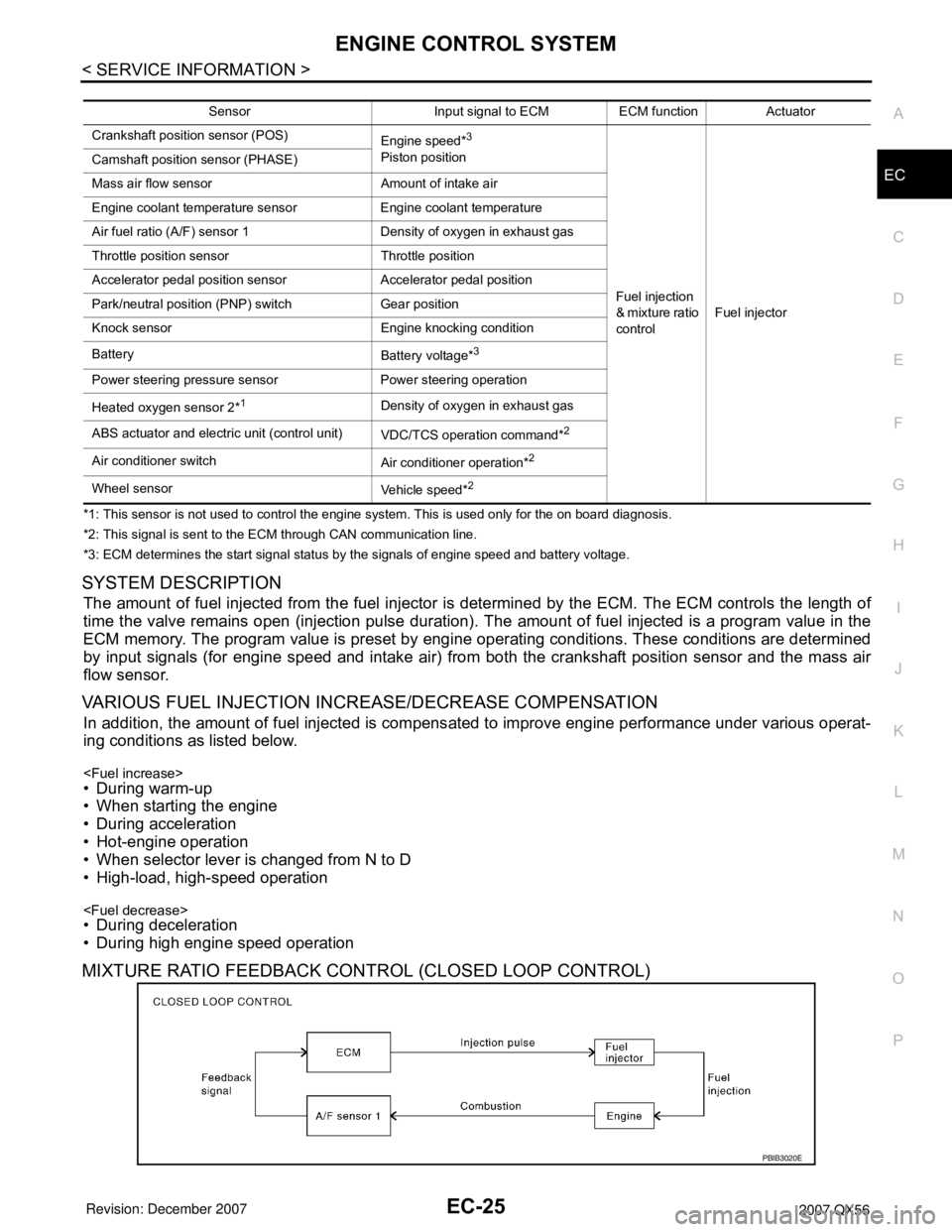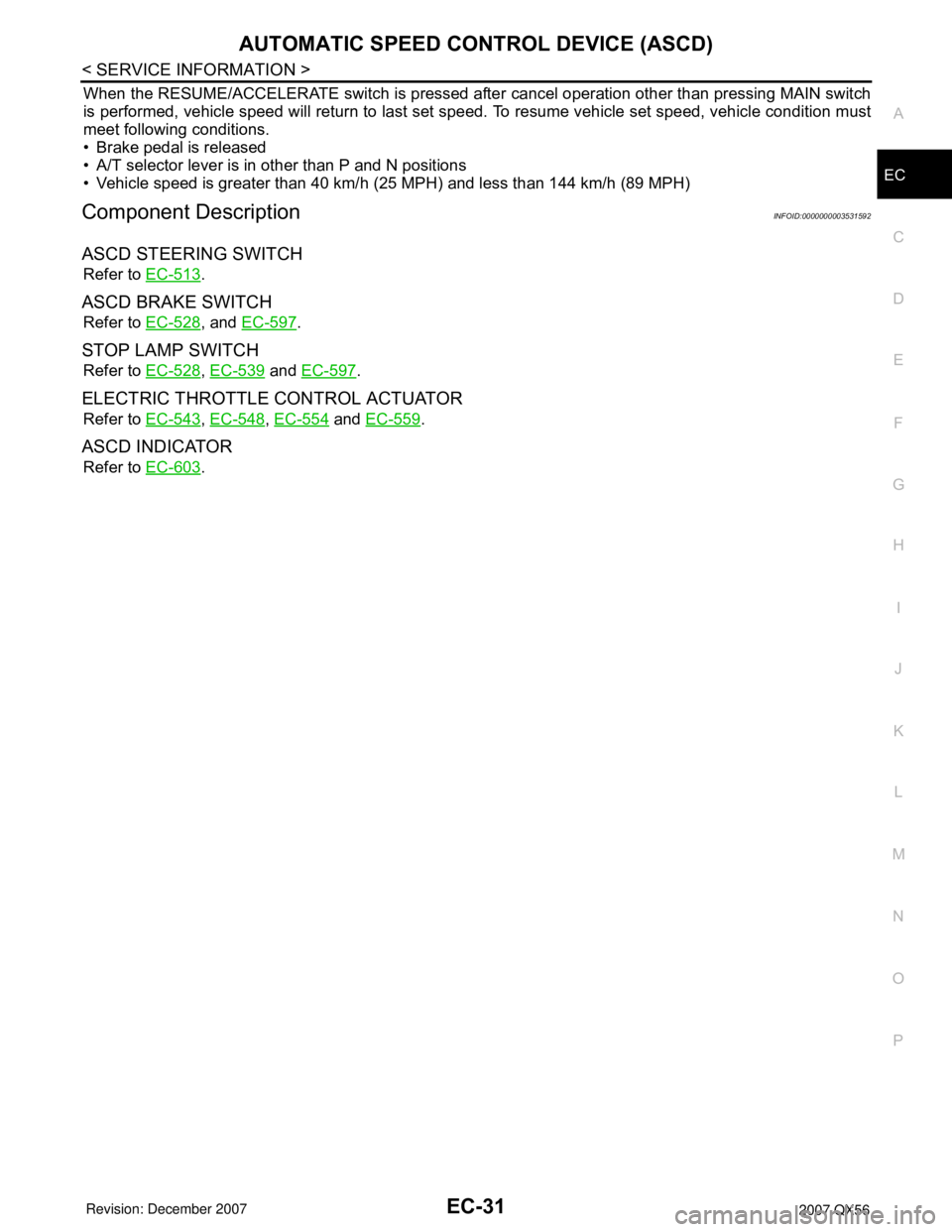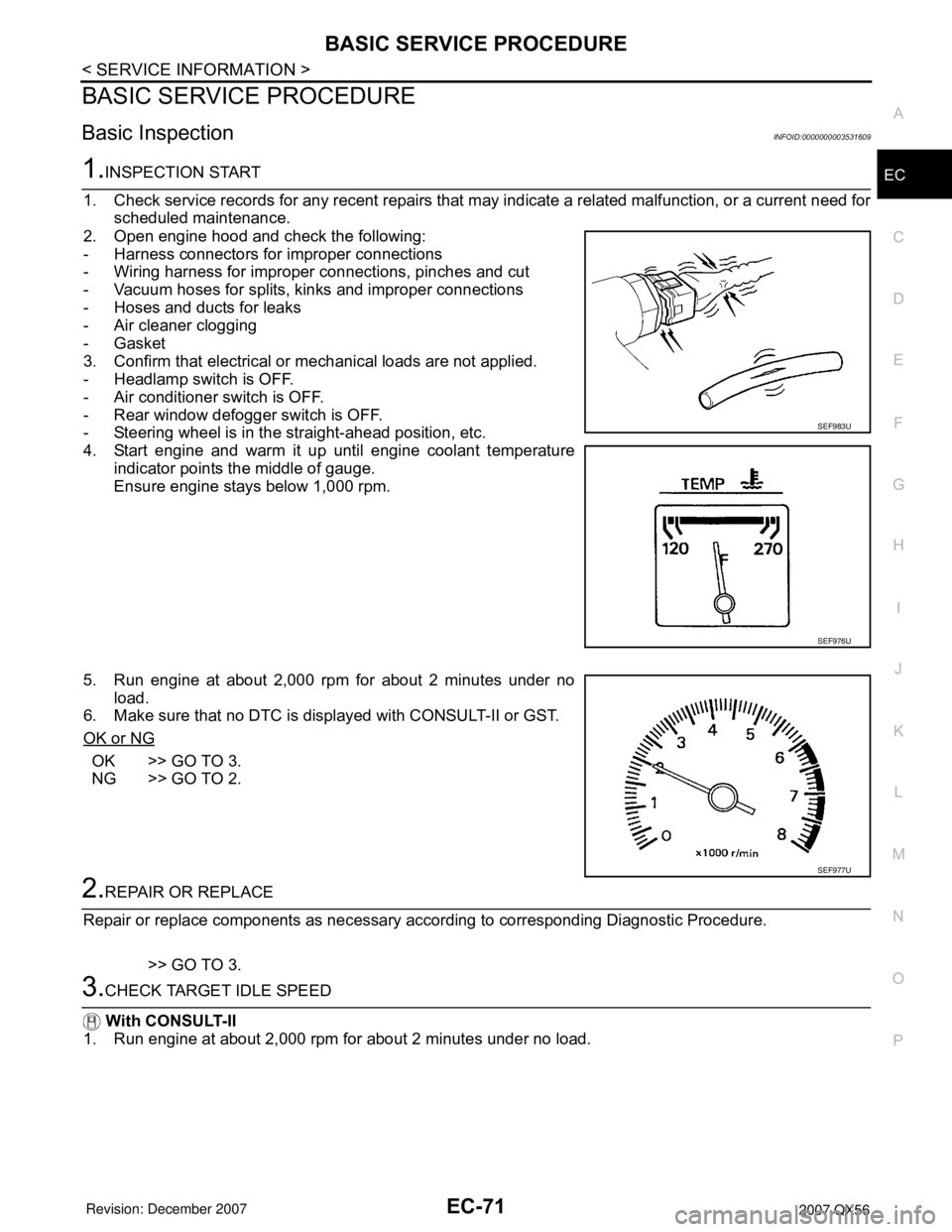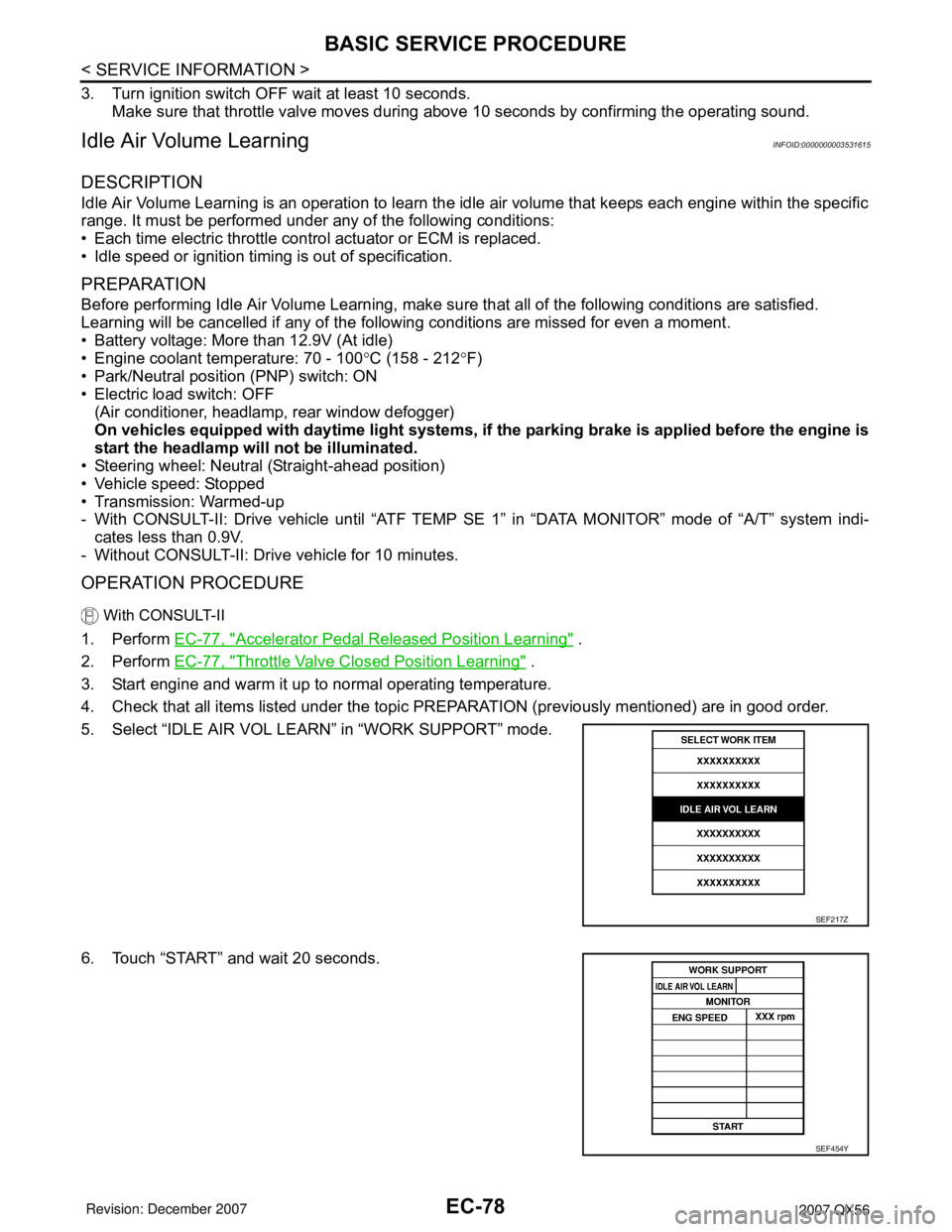2007 INFINITI QX56 steering
[x] Cancel search: steeringPage 988 of 3061
![INFINITI QX56 2007 Factory Service Manual BRC-60
< SERVICE INFORMATION >[VDC/TCS/ABS]
STEERING ANGLE SENSOR
STEERING ANGLE SENSOR
Removal and InstallationINFOID:0000000003532814
REMOVAL
1. Remove the spiral cable. Refer to SRS-37, "Removal an INFINITI QX56 2007 Factory Service Manual BRC-60
< SERVICE INFORMATION >[VDC/TCS/ABS]
STEERING ANGLE SENSOR
STEERING ANGLE SENSOR
Removal and InstallationINFOID:0000000003532814
REMOVAL
1. Remove the spiral cable. Refer to SRS-37, "Removal an](/manual-img/42/57029/w960_57029-987.png)
BRC-60
< SERVICE INFORMATION >[VDC/TCS/ABS]
STEERING ANGLE SENSOR
STEERING ANGLE SENSOR
Removal and InstallationINFOID:0000000003532814
REMOVAL
1. Remove the spiral cable. Refer to SRS-37, "Removal and Installation".
2. Remove the screws and remove the steering angle sensor.
CAUTION:
In the case that the ABS actuator and electronic unit (control unit) is replaced, make sure to adjust
position of steering angle sensor. Refer to BRC-54, "
Adjustment of Steering Angle Sensor Neutral
Position".
INSTALLATION
1. Installation is in the reverse order of removal.
Page 1090 of 3061

EC-7
C
D
E
F
G
H
I
J
K
L
M
ECA
N
O
P
DTC P1564 ICC STEERING SWITCH .............507
Component Description .........................................507
CONSULT-II Reference Value in Data Monitor
Mode .....................................................................
507
On Board Diagnosis Logic ....................................507
DTC Confirmation Procedure ................................507
Wiring Diagram .....................................................509
Diagnosis Procedure .............................................510
Component Inspection ..........................................512
DTC P1564 ASCD STEERING SWITCH .........513
Component Description .........................................513
CONSULT-II Reference Value in Data Monitor
Mode .....................................................................
513
On Board Diagnosis Logic ....................................513
DTC Confirmation Procedure ................................513
Wiring Diagram .....................................................515
Diagnosis Procedure .............................................516
Component Inspection ..........................................518
DTC P1568 ICC FUNCTION ............................519
On Board Diagnosis Logic ....................................519
DTC Confirmation Procedure ................................519
Diagnosis Procedure .............................................519
DTC P1572 ICC BRAKE SWITCH ...................520
Component Description .........................................520
CONSULT-II Reference Value in Data Monitor
Mode .....................................................................
520
On Board Diagnosis Logic ....................................520
DTC Confirmation Procedure ................................520
Wiring Diagram .....................................................522
Diagnosis Procedure .............................................523
Component Inspection ..........................................526
DTC P1572 ASCD BRAKE SWITCH ...............528
Component Description .........................................528
CONSULT-II Reference Value in Data Monitor
Mode .....................................................................
528
On Board Diagnosis Logic ....................................528
DTC Confirmation Procedure ................................528
Wiring Diagram .....................................................530
Diagnosis Procedure .............................................531
Component Inspection ..........................................534
DTC P1574 ICC VEHICLE SPEED SENSOR ..535
Component Description .........................................535
On Board Diagnosis Logic ....................................535
DTC Confirmation Procedure ................................535
Diagnosis Procedure .............................................536
DTC P1574 ASCD VEHICLE SPEED SEN-
SOR ..................................................................
537
Component Description .........................................537
On Board Diagnosis Logic ....................................537
DTC Confirmation Procedure ................................537
Diagnosis Procedure .............................................538
DTC P1805 BRAKE SWITCH ..........................539
Description ............................................................539
CONSULT-II Reference Value in Data Monitor
Mode ......................................................................
539
On Board Diagnosis Logic .....................................539
DTC Confirmation Procedure ................................539
Wiring Diagram ......................................................540
Diagnosis Procedure .............................................541
Component Inspection ...........................................542
DTC P2100, P2103 THROTTLE CONTROL
MOTOR RELAY ..............................................
543
Component Description .........................................543
CONSULT-II Reference Value in Data Monitor
Mode ......................................................................
543
On Board Diagnosis Logic .....................................543
DTC Confirmation Procedure ................................543
Wiring Diagram ......................................................545
Diagnosis Procedure .............................................546
DTC P2101 ELECTRIC THROTTLE CON-
TROL FUNCTION ...........................................
548
Description .............................................................548
On Board Diagnosis Logic .....................................548
DTC Confirmation Procedure ................................548
Wiring Diagram ......................................................549
Diagnosis Procedure .............................................550
Component Inspection ...........................................553
Removal and Installation .......................................553
DTC P2118 THROTTLE CONTROL MOTOR .554
Component Description .........................................554
On Board Diagnosis Logic .....................................554
DTC Confirmation Procedure ................................554
Wiring Diagram ......................................................555
Diagnosis Procedure .............................................556
Component Inspection ...........................................557
Removal and Installation .......................................557
DTC P2119 ELECTRIC THROTTLE CON-
TROL ACTUATOR ..........................................
559
Component Description .........................................559
On Board Diagnosis Logic .....................................559
DTC Confirmation Procedure ................................559
Diagnosis Procedure .............................................560
DTC P2122, P2123 APP SENSOR .................561
Component Description .........................................561
CONSULT-II Reference Value in Data Monitor
Mode ......................................................................
561
On Board Diagnosis Logic .....................................561
DTC Confirmation Procedure ................................561
Wiring Diagram ......................................................563
Diagnosis Procedure .............................................564
Component Inspection ...........................................566
Removal and Installation .......................................566
DTC P2127, P2128 APP SENSOR .................567
Component Description .........................................567
CONSULT-II Reference Value in Data Monitor
Mode ......................................................................
567
On Board Diagnosis Logic .....................................567
Page 1108 of 3061

ENGINE CONTROL SYSTEM
EC-25
< SERVICE INFORMATION >
C
D
E
F
G
H
I
J
K
L
MA
EC
N
P O
*1: This sensor is not used to control the engine system. This is used only for the on board diagnosis.
*2: This signal is sent to the ECM through CAN communication line.
*3: ECM determines the start signal status by the signals of engine speed and battery voltage.
SYSTEM DESCRIPTION
The amount of fuel injected from the fuel injector is determined by the ECM. The ECM controls the length of
time the valve remains open (injection pulse duration). The amount of fuel injected is a program value in the
ECM memory. The program value is preset by engine operating conditions. These conditions are determined
by input signals (for engine speed and intake air) from both the crankshaft position sensor and the mass air
flow sensor.
VARIOUS FUEL INJECTION INCREASE/DECREASE COMPENSATION
In addition, the amount of fuel injected is compensated to improve engine performance under various operat-
ing conditions as listed below.
• When starting the engine
• During acceleration
• Hot-engine operation
• When selector lever is changed from N to D
• High-load, high-speed operation
• During deceleration
• During high engine speed operation
MIXTURE RATIO FEEDBACK CONTROL (CLOSED LOOP CONTROL)
Sensor Input signal to ECM ECM function Actuator
Crankshaft position sensor (POS)
Engine speed*
3
Piston position
Fuel injection
& mixture ratio
controlFuel injector Camshaft position sensor (PHASE)
Mass air flow sensor Amount of intake air
Engine coolant temperature sensor Engine coolant temperature
Air fuel ratio (A/F) sensor 1 Density of oxygen in exhaust gas
Throttle position sensor Throttle position
Accelerator pedal position sensor Accelerator pedal position
Park/neutral position (PNP) switch Gear position
Knock sensor Engine knocking condition
Battery
Battery voltage*
3
Power steering pressure sensor Power steering operation
Heated oxygen sensor 2*
1Density of oxygen in exhaust gas
ABS actuator and electric unit (control unit)
VDC/TCS operation command*
2
Air conditioner switch
Air conditioner operation*2
Wheel sensor
Vehicle speed*2
PBIB3020E
Page 1112 of 3061

AIR CONDITIONING CUT CONTROL
EC-29
< SERVICE INFORMATION >
C
D
E
F
G
H
I
J
K
L
MA
EC
N
P O
AIR CONDITIONING CUT CONTROL
Input/Output Signal ChartINFOID:0000000003531589
*1: This signal is sent to the ECM through CAN communication line.
*2: ECM determines the start signal status by the signals of engine speed and battery voltage.
System DescriptionINFOID:0000000003531590
This system improves engine operation when the air conditioner is used.
Under the following conditions, the air conditioner is turned OFF.
• When the accelerator pedal is fully depressed.
• When cranking the engine.
• At high engine speeds.
• When the engine coolant temperature becomes excessively high.
• When operating power steering during low engine speed or low vehicle speed.
• When engine speed is excessively low.
• When refrigerant pressure is excessively low or high.
Sensor Input Signal to ECM ECM function Actuator
Air conditioner switch
Air conditioner ON signal*
1
Air conditioner
cut controlAir conditioner relay Accelerator pedal position sensor Accelerator pedal position
Crankshaft position sensor (POS)
Camshaft position sensor (PHASE)Engine speed*
2
Engine coolant temperature sensor Engine coolant temperature
Battery
Battery voltage*
2
Refrigerant pressure sensor Refrigerant pressure
Power steering pressure sensor Power steering operation
Wheel sensor
Vehicle speed*
1
Page 1113 of 3061

EC-30
< SERVICE INFORMATION >
AUTOMATIC SPEED CONTROL DEVICE (ASCD)
AUTOMATIC SPEED CONTROL DEVICE (ASCD)
System DescriptionINFOID:0000000003531591
INPUT/OUTPUT SIGNAL CHART
*: This signal is sent to the ECM through CAN communication line
BASIC ASCD SYSTEM
Refer to Owner's Manual for ASCD operating instructions.
Automatic Speed Control Device (ASCD) allows a driver to keep vehicle at predetermined constant speed
without depressing accelerator pedal. Driver can set vehicle speed in advance between approximately 40 km/
h (25 MPH) and 144 km/h (89 MPH).
ECM controls throttle angle of electric throttle control actuator to regulate engine speed.
Operation status of ASCD is indicated by CRUISE indicator and SET indicator in combination meter. If any
malfunction occurs in ASCD system, it automatically deactivates control.
NOTE:
Always drive vehicle in safe manner according to traffic conditions and obey all traffic laws.
SET OPERATION
Press MAIN switch. (The CRUISE indicator in combination meter illuminates.)
When vehicle speed reaches a desired speed between approximately 40 km/h (25 MPH) and 144 km/h (89
MPH), press SET/COAST switch. (Then SET indicator in combination meter illuminates.)
ACCELERATE OPERATION
If the RESUME/ACCELERATE switch is pressed during cruise control driving, increase the vehicle speed until
the switch is released or vehicle speed reaches maximum speed controlled by the system.
And then ASCD will keep the new set speed.
CANCEL OPERATION
When any of following conditions exist, cruise operation will be canceled.
• CANCEL switch is pressed
• More than 2 switches at ASCD steering switch are pressed at the same time (Set speed will be cleared)
• Brake pedal is depressed
• Selector lever is changed to N, P, R position
• Vehicle speed decreased to 13 km/h (8 MPH) lower than the set speed
• VDC system is operated
When the ECM detects any of the following conditions, the ECM will cancel the cruise operation and inform
the driver by blinking indicator lamp.
• Engine coolant temperature is slightly higher than the normal operating temperature, CRUISE lamp may
blink slowly.
When the engine coolant temperature decreases to the normal operating temperature, CRUISE lamp will
stop blinking and the cruise operation will be able to work by pressing SET/COAST switch or RESUME/
ACCELERATE switch.
• Malfunction for some self-diagnoses regarding ASCD control: SET lamp will blink quickly.
If MAIN switch is turned to OFF during ASCD is activated, all of ASCD operations will be canceled and vehicle
speed memory will be erased.
COAST OPERATION
When the SET/COAST switch is pressed during cruise control driving, decrease vehicle set speed until the
switch is released. And then ASCD will keep the new set speed.
RESUME OPERATION
Sensor Input signal to ECM ECM function Actuator
ASCD brake switch Brake pedal operation
ASCD vehicle speed controlElectric throttle control
actuator Stop lamp switch Brake pedal operation
ASCD steering switch ASCD steering switch operation
Park/neutral position (PNP) switch Gear position
Wheel sensor Vehicle speed*
TCM Powertrain revolution*
Page 1114 of 3061

AUTOMATIC SPEED CONTROL DEVICE (ASCD)
EC-31
< SERVICE INFORMATION >
C
D
E
F
G
H
I
J
K
L
MA
EC
N
P O
When the RESUME/ACCELERATE switch is pressed after cancel operation other than pressing MAIN switch
is performed, vehicle speed will return to last set speed. To resume vehicle set speed, vehicle condition must
meet following conditions.
• Brake pedal is released
• A/T selector lever is in other than P and N positions
• Vehicle speed is greater than 40 km/h (25 MPH) and less than 144 km/h (89 MPH)
Component DescriptionINFOID:0000000003531592
ASCD STEERING SWITCH
Refer to EC-513.
ASCD BRAKE SWITCH
Refer to EC-528, and EC-597.
STOP LAMP SWITCH
Refer to EC-528, EC-539 and EC-597.
ELECTRIC THROTTLE CONTROL ACTUATOR
Refer to EC-543, EC-548, EC-554 and EC-559.
ASCD INDICATOR
Refer to EC-603.
Page 1154 of 3061

BASIC SERVICE PROCEDURE
EC-71
< SERVICE INFORMATION >
C
D
E
F
G
H
I
J
K
L
MA
EC
N
P O
BASIC SERVICE PROCEDURE
Basic InspectionINFOID:0000000003531609
1.INSPECTION START
1. Check service records for any recent repairs that may indicate a related malfunction, or a current need for
scheduled maintenance.
2. Open engine hood and check the following:
- Harness connectors for improper connections
- Wiring harness for improper connections, pinches and cut
- Vacuum hoses for splits, kinks and improper connections
- Hoses and ducts for leaks
- Air cleaner clogging
- Gasket
3. Confirm that electrical or mechanical loads are not applied.
- Headlamp switch is OFF.
- Air conditioner switch is OFF.
- Rear window defogger switch is OFF.
- Steering wheel is in the straight-ahead position, etc.
4. Start engine and warm it up until engine coolant temperature
indicator points the middle of gauge.
Ensure engine stays below 1,000 rpm.
5. Run engine at about 2,000 rpm for about 2 minutes under no
load.
6. Make sure that no DTC is displayed with CONSULT-II or GST.
OK or NG
OK >> GO TO 3.
NG >> GO TO 2.
2.REPAIR OR REPLACE
Repair or replace components as necessary according to corresponding Diagnostic Procedure.
>> GO TO 3.
3.CHECK TARGET IDLE SPEED
With CONSULT-II
1. Run engine at about 2,000 rpm for about 2 minutes under no load.
SEF983U
SEF976U
SEF977U
Page 1161 of 3061

EC-78
< SERVICE INFORMATION >
BASIC SERVICE PROCEDURE
3. Turn ignition switch OFF wait at least 10 seconds.
Make sure that throttle valve moves during above 10 seconds by confirming the operating sound.
Idle Air Volume LearningINFOID:0000000003531615
DESCRIPTION
Idle Air Volume Learning is an operation to learn the idle air volume that keeps each engine within the specific
range. It must be performed under any of the following conditions:
• Each time electric throttle control actuator or ECM is replaced.
• Idle speed or ignition timing is out of specification.
PREPARATION
Before performing Idle Air Volume Learning, make sure that all of the following conditions are satisfied.
Learning will be cancelled if any of the following conditions are missed for even a moment.
• Battery voltage: More than 12.9V (At idle)
• Engine coolant temperature: 70 - 100°C (158 - 212°F)
• Park/Neutral position (PNP) switch: ON
• Electric load switch: OFF
(Air conditioner, headlamp, rear window defogger)
On vehicles equipped with daytime light systems, if the parking brake is applied before the engine is
start the headlamp will not be illuminated.
• Steering wheel: Neutral (Straight-ahead position)
• Vehicle speed: Stopped
• Transmission: Warmed-up
- With CONSULT-II: Drive vehicle until “ATF TEMP SE 1” in “DATA MONITOR” mode of “A/T” system indi-
cates less than 0.9V.
- Without CONSULT-II: Drive vehicle for 10 minutes.
OPERATION PROCEDURE
With CONSULT-II
1. Perform EC-77, "Accelerator Pedal Released Position Learning" .
2. Perform EC-77, "
Throttle Valve Closed Position Learning" .
3. Start engine and warm it up to normal operating temperature.
4. Check that all items listed under the topic PREPARATION (previously mentioned) are in good order.
5. Select “IDLE AIR VOL LEARN” in “WORK SUPPORT” mode.
6. Touch “START” and wait 20 seconds.
SEF217Z
SEF454Y